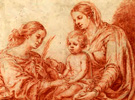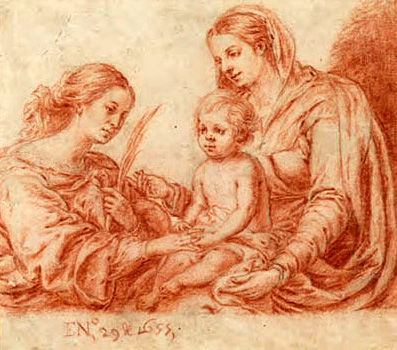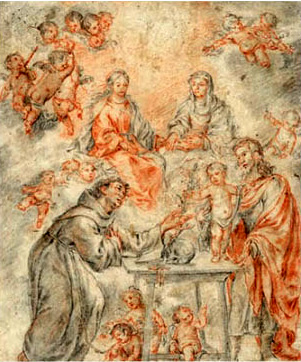Meadows Museum to present exhibition of masterworks
from the Hamburger Kunsthalle
One of the world's most significant collections of Spanish drawings goes on exhibit at the Meadows Museum.

DALLAS (SMU) – This summer, the Meadows Museum will present the first large-scale exhibition of drawings from the Kupferstichkabinett at the Hamburger Kunsthalle, one of the most significant collections of Spanish drawings in the world.
 Bartolorne Esteban rvlurillo (1617-1682), The Mystic Marriage of St. Catherine, 1655. Red chalk over traces of black chalk. Hamburger Kunsthalle, Kupferstichkabinett (38592). |
It will be the first exhibition outside of Germany to showcase the collection, and will provide an intimate exploration of these masters’ draftsmanship and technique, as well as a comprehensive look into the collection’s origins and history.
Curated by independent art historian Dr. Jens Hoffmann-Samland, The Spanish Gestureis part of the Meadows’ ongoing initiative to further enhance its role as a leading center for research and scholarship on Spanish art, and will be on view in Dallas from May 25 through August 31, 2014. The exhibition will subsequently travel to the Museo Nacional del Prado in Madrid, where it will be on view from October 28, 2014 through February 8, 2015.
In its entirety, the collection comprises 210 drawings of Spanish origin. Most of the drawings entered the Hamburger Kunsthalle collection in 1891, when the institution’s first director, Alfred Lichtwark, acquired the works. Lichtwark had viewed the collection while on display in Berlin and, impressed by its dynamism and breadth, immediately secured the necessary funds and purchased the collection from then- owner Bernard Quaritch, a London-based art collector and antiques dealer. Yet the collection soon faded from public memory, only resurfacing sporadically for small in-house exhibitions in 1931, 1966, and 2005.
"The Spanish Gesture will provide a unique opportunity to engage with rare and exquisite drawings that complement the works in the Meadows Museum collection," said Mark A. Roglán, the Linda P. and William A. Custard Director of the Meadows Museum. "We are excited to partner with the Hamburger Kunsthalle, and to continue to strengthen our long-standing relationship with the Prado, in sharing these artists’ creative processes with the public in an intimate and unprecedented way. This exhibition will bring us closer to developing comprehensive scholarship of Spanish drawings worldwide, and will help further the appreciation and understanding of Spanish drawings as a distinctive and expressive artistic genre."
The core of the works in the collection were produced and assembled in the mid-17th century, in and around the Academia de Murillo, established by Bartolomé Esteban Murillo, Francisco Herrera the Younger, Juan de Valdes Leal, and Cornelis Schut, among others, in Seville. Some highlights of the exhibition include Murillo’s Assumption of the Virgin (c. 1665), Herrera the Younger’s Nobleman in a Landscape (c. 1660), Valdés Leal’s Head of St. John the Baptist (1654-55), and Alonso Cano’s Sketch for the Altar of St. Catherine.
 Juan de Valdes Leal (1622-1690), The Vision of St. Anthony, 1665. Black and red crayon on light gray Verge paper. Hamburger Kunsthalle, Kupferstichkabinett (38627). |
Additionally, the collection holds the largest group of half-length holy figures (c. 1640-50), purported to represent the twelve apostles, by Francisco Herrera the Elder. The Spanish Gesture will be the first exhibition in which all twelve figures are displayed concurrently. Together, these works will illustrate the artistic vision, processes, and influences of these renowned masters, and will provide new insight into the dynamic exchange that pervaded the Spanish creative community in the 17th century.
The Spanish Gesture will also feature a number of drawings by Francisco Goya, and the majority of Goya’s drawings after the works of Diego Velázquez, many of which were used for etchings. The works Goya emulated depict a range of subject matter, including full-length portraits of members of the Spanish royal family and their court, and one of Velázquez’s most important early works, the Waterseller of Seville. Goya’s drawings will encourage viewers to consider the significant impact of Velázquez’s work anew, as well as reveal Goya’s own artistic influences and processes. The exhibition will also feature drawings related to Goya’s most famous etching series, “Los Caprichos” and “La Tauromaquia.”
The exhibition has been organized by the Meadows Museum, SMU, the Hamburger Kunsthalle, and the Museo Nacional del Prado, and is funded by a generous gift from The Meadows Foundation.
Promotional support provided by the Dallas Morning News.
The Spanish Gesture comes as the Meadows Museum prepares for its 50th anniversary in 2015. It will be accompanied by an illustrated exhibition catalogue, which will include a catalogue raisonné of the entire collection of 210 drawings, and will be collaboratively published by the Meadows and the aforementioned institutions in English and Spanish.
About the Meadows Museum
The Meadows Museum is the leading institution in the U.S. focused on the study and presentation of the art of Spain. In 1962, Dallas businessman and philanthropist Algur H. Meadows donated his private collection of Spanish paintings, as well as funds to start a museum, to Southern Methodist University. The museum opened to the public in 1965 and today is home to one of the largest and most comprehensive collections of Spanish art outside of Spain. The collection includes medieval objects, Renaissance and Baroque sculptures, and major paintings by Golden Age and modern masters.
###